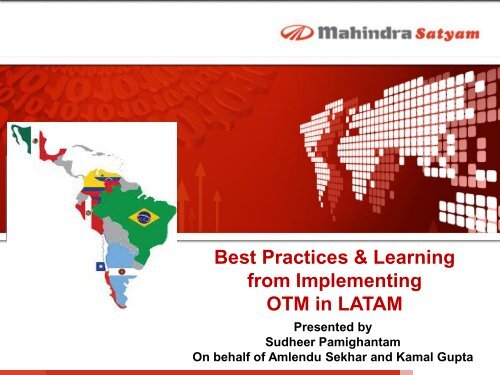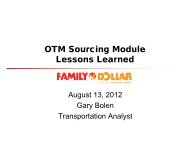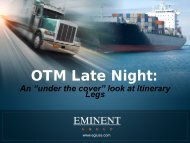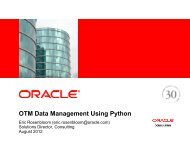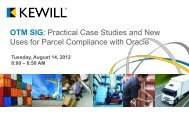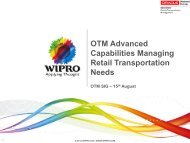Best Practices & Learning from Implementing OTM in LATAM
Best Practices & Learning from Implementing OTM in LATAM
Best Practices & Learning from Implementing OTM in LATAM
Create successful ePaper yourself
Turn your PDF publications into a flip-book with our unique Google optimized e-Paper software.
© Mah<strong>in</strong>dra Satyam 2012 2009<br />
<strong>Best</strong> <strong>Practices</strong> & <strong>Learn<strong>in</strong>g</strong><br />
<strong>from</strong> <strong>Implement<strong>in</strong>g</strong><br />
<strong>OTM</strong> <strong>in</strong> <strong>LATAM</strong><br />
Presented by<br />
Sudheer Pamighantam<br />
On behalf of Amlendu Sekhar and Kamal Gupta
Context<br />
This paper is not <strong>in</strong>tended to be comprehensive coverage of all th<strong>in</strong>gs <strong>in</strong> <strong>LATAM</strong>,<br />
but to share experience <strong>from</strong> <strong>OTM</strong> engagements<br />
Basis of Experience<br />
Country Customer / Prospect Nature of Engagement<br />
Brazil LSP <strong>OTM</strong> Implementation<br />
Brazil Retailer <strong>OTM</strong> Enhancements<br />
Brazil Onl<strong>in</strong>e Retailer <strong>OTM</strong> Support<br />
Brazil Aircraft Manufactur<strong>in</strong>g GTM Implementation<br />
Argent<strong>in</strong>a CPG <strong>OTM</strong> Implementation<br />
Mexico LSP (NA) <strong>OTM</strong> Implementation<br />
Mexico LSP (NA) <strong>OTM</strong> Enhancements<br />
Several Several (LSP, Retail, Mfg, Energy) Presales consult<strong>in</strong>g<br />
© Mah<strong>in</strong>dra Satyam 2012<br />
2
Section<br />
Section<br />
Section<br />
Section<br />
© Mah<strong>in</strong>dra Satyam 2012<br />
1<br />
2<br />
3<br />
4<br />
Section 5<br />
Contents<br />
Opportunities <strong>in</strong> <strong>LATAM</strong> & Impact on Logistics<br />
Challenges <strong>in</strong> <strong>LATAM</strong> Region<br />
<strong>OTM</strong> for <strong>LATAM</strong><br />
Implementation Approach<br />
Q & A<br />
3
<strong>LATAM</strong> is Grow<strong>in</strong>g<br />
Domestic Consumption & International Trade<br />
Lat<strong>in</strong> America on a Growth path<br />
�Rapid Recovery <strong>from</strong> 2009<br />
downturn<br />
�Cont<strong>in</strong>ued Capital Inflows<br />
�Strong Domestic Demand<br />
�Cont<strong>in</strong>ued political stability<br />
�Free trade agreements<br />
© Mah<strong>in</strong>dra Satyam 2012<br />
Source: The Institute of International F<strong>in</strong>ance, Inc.<br />
Challenges <strong>in</strong>clude tax laws, political and regulatory obstacles and logistics <strong>in</strong>frastructure<br />
4
Impact of Growth on Logistics<br />
Shipper Perspective<br />
Growth <strong>in</strong> Manufactur<strong>in</strong>g and Consumer Goods<br />
� Consumer, Food, Beverage and Retail <strong>in</strong>dustries<br />
� Manufactur<strong>in</strong>g -Near-shor<strong>in</strong>g at Mexico:<br />
- Competitive labor rates<br />
- Logistics Advantages<br />
- Lead time & Risk management<br />
� Petrochemical / Chemical and Cosmetics<br />
� Infrastructure<br />
Why <strong>OTM</strong>?<br />
- Visibility across supply cha<strong>in</strong> and related event management<br />
- Transportation cost optimization<br />
- Performance Improvement & monitor<strong>in</strong>g<br />
- Process Automation<br />
- Compliance to Government Regulations<br />
© Mah<strong>in</strong>dra Satyam 2012<br />
Lead<strong>in</strong>g to need for new process / technology<br />
� Re-design process and deploy technology to<br />
support growth:<br />
- Products / Channels<br />
- Volumes<br />
� Leverage opportunity to <strong>in</strong>tegrate <strong>LATAM</strong><br />
with global process and systems<br />
5
Significant Opportunities for LSPs<br />
How can <strong>OTM</strong> Help?<br />
Why<br />
<strong>OTM</strong>?<br />
© Mah<strong>in</strong>dra Satyam 2012<br />
<strong>LATAM</strong> Logistics Market Size Market Opportunities<br />
Capture opportunities <strong>in</strong><br />
emerg<strong>in</strong>g markets<br />
Drive growth <strong>from</strong> new /<br />
<strong>in</strong>tegrated services<br />
• Logistics market growth<br />
<strong>from</strong> 272 B <strong>in</strong> 2008 to<br />
333 B by 2013<br />
• 3PL Market size: $33 B<br />
• Road segment as% of<br />
the <strong>LATAM</strong> logistics<br />
market: 88.4% (2008)<br />
• In addition to<br />
International Logistics,<br />
domestic logistics<br />
services is grow<strong>in</strong>g<br />
Create LSP IT Platform to<br />
drive this growth<br />
6
Section<br />
Section<br />
Section<br />
Section<br />
© Mah<strong>in</strong>dra Satyam 2012<br />
1<br />
2<br />
3<br />
4<br />
Section 5<br />
Contents<br />
Opportunities <strong>in</strong> <strong>LATAM</strong> & Impact on Logistics<br />
Challenges <strong>in</strong> <strong>LATAM</strong> Region<br />
<strong>OTM</strong> for <strong>LATAM</strong><br />
Implementation Approach<br />
Q & A<br />
7
Challenges <strong>in</strong> <strong>LATAM</strong><br />
© Mah<strong>in</strong>dra Satyam 2012<br />
Operational Differences<br />
• How logistics bus<strong>in</strong>ess is<br />
conducted<br />
• Impact of Fiscal and<br />
F<strong>in</strong>ancial processes<br />
Fiscal & Related Changes<br />
• Complex Fiscal Rules<br />
• Constant Changes <strong>in</strong><br />
regulations that need to be met<br />
F<strong>in</strong>ancial processes<br />
• Local f<strong>in</strong>ancial processes<br />
related to logistics<br />
transactions<br />
• Meet<strong>in</strong>g Regulatory<br />
Requirements<br />
8
Challenges <strong>in</strong> <strong>LATAM</strong><br />
Key challenges<br />
specific to <strong>LATAM</strong>:<br />
1) Fiscal &<br />
Regulatory<br />
Requirements<br />
2) F<strong>in</strong>ancial<br />
Processes<br />
3) Operational<br />
Differences<br />
© Mah<strong>in</strong>dra Satyam 2012<br />
Municipal B<br />
Municipal A<br />
1. Fiscal & Regulatory Requirements (Brazil)<br />
CTe<br />
NFS<br />
Federal Federal Taxes: PIS – COFINS<br />
State State Specific Rules for ICMS<br />
Municipality<br />
(Local City Adm<strong>in</strong>istration)<br />
Mexico: IVA and Retention<br />
Municipal Specific Rules for ISS<br />
Municipal A<br />
9
Brazil Fiscal – Sample Scenarios<br />
1. Normal CT-e can be cancelled, voided and substituted.<br />
2. Multiple Complementary CTes can be created. Complementary CT-e must refer to a Orig<strong>in</strong>al CT-e<br />
3. Every CT-e should have CT-e number /series<br />
4. User cannot generate a complementary for a complementary CTe<br />
5. Cancellation of CT-e is allowed only if the shipment is not <strong>in</strong> transit<br />
6. CT-e cannot be cancelled if the CT-e is already sent for Authorization and Authorization Response is<br />
not received back<br />
© Mah<strong>in</strong>dra Satyam 2012<br />
CTe NFS<br />
Inter-Municipal scenario Intra-Municipal scenario<br />
Generated before transportation execution Generated after transportation execution<br />
Requires govt. sanction Doesn’t require govt. sanctions<br />
ICMS Tax applicable ICMS not applicable<br />
ISS Tax not applicable ISS Tax applicable<br />
Each CTE corresponds to unique sell shipment Multiple sell shipments can be grouped <strong>in</strong> 1 NFS<br />
7. Complementary CT-e can be generated only when the CT-e of orig<strong>in</strong> is approved by SEFAZ<br />
8. Cancelled CT-e numbers should not be reused further<br />
10
Challenges <strong>in</strong> <strong>LATAM</strong><br />
Key challenges<br />
specific to <strong>LATAM</strong>:<br />
1) Fiscal &<br />
Regulatory<br />
Requirements<br />
2) F<strong>in</strong>ancial<br />
Processes<br />
3) Operational<br />
Differences<br />
© Mah<strong>in</strong>dra Satyam 2012<br />
2. F<strong>in</strong>ancial Process<strong>in</strong>g<br />
Payment Match<strong>in</strong>g Process based <strong>in</strong> Fiscal Document (CTe/CTRC/NFS/NFS-e)<br />
Events need to be considered <strong>in</strong> Bill<strong>in</strong>g and Payment Process.<br />
Bill<strong>in</strong>g process is based on F<strong>in</strong>ancial and Fiscal Documents<br />
(CTRC/CT-e/NFS/NFS-e/Pre-Invoice/Invoice)<br />
Workflow to approval differences (Adjustments) and<br />
Payments (release Invoice to ERP)<br />
Break Bill<strong>in</strong>g Invoice based on Customer Rules (Eg : Amount<br />
Limit , Quantity CT-e per Invoice, Region, Modal, Type of<br />
Products, etc)<br />
Cost Allocation Rules: Multiple Allocation rules with specific<br />
sub rules<br />
Argent<strong>in</strong>a: Carrier updates the taxes applicable based on<br />
which tax calculation for Invoic<strong>in</strong>g was done<br />
11
F<strong>in</strong>ancial Process<strong>in</strong>g – Carrier Payment - High Level Flow<br />
Multi transaction<br />
Payment process<br />
Transportation<br />
requires specific<br />
documentation,<br />
triggered by predef<strong>in</strong>ed<br />
events<br />
© Mah<strong>in</strong>dra Satyam 2012<br />
LSP/<br />
Shipper<br />
NOTFIS<br />
OCOREN (Events)<br />
CONEMB (CT-/NFS)<br />
PREFAT (Pre-Invoice)<br />
DOCCOB (Invoice)<br />
C<br />
A<br />
R<br />
R<br />
I<br />
E<br />
R<br />
S<br />
12
F<strong>in</strong>ancial Process<strong>in</strong>g– Customer Bill<strong>in</strong>g - High Level Flow<br />
Multi transaction<br />
Invoic<strong>in</strong>g process<br />
Transportation<br />
requires specific<br />
documentation,<br />
triggered by predef<strong>in</strong>ed<br />
events<br />
© Mah<strong>in</strong>dra Satyam 2012<br />
LSP/<br />
Shipper<br />
NOTFIS (Order Release)<br />
OCOREN (Events)<br />
CONEMB (CT-e/NFS)<br />
PREFAT (Pre-Invoice)<br />
DOCCOB (Invoice)<br />
C<br />
U<br />
S<br />
T<br />
O<br />
M<br />
E<br />
R<br />
S<br />
13
Challenges <strong>in</strong> <strong>LATAM</strong><br />
Key challenges<br />
specific to <strong>LATAM</strong>:<br />
1) Fiscal &<br />
Regulatory<br />
Requirements<br />
2) F<strong>in</strong>ancial<br />
Processes<br />
3) Operational<br />
Differences<br />
© Mah<strong>in</strong>dra Satyam 2012<br />
3. Operational Difference<br />
• Cte/Sell shipment Group<strong>in</strong>g Rule<br />
• Integration with Last Mile Rout<strong>in</strong>g Application<br />
• OTD/FIDEP Concept<br />
• Dedicated fleet<br />
• RMP<br />
• OCCOREN file upload to send events<br />
• Redelivery/Return shipments<br />
• Proximity scenario<br />
• Refuse scenario<br />
• Beeper Interface Design<br />
• Reserve Dock/Appo<strong>in</strong>tment Schedul<strong>in</strong>g by Carriers<br />
14
Operational Difference<br />
CTe /Sell Shipment<br />
Group<strong>in</strong>g<br />
Integration with Last<br />
Mile Rout<strong>in</strong>g<br />
Application<br />
Dedicated Fleet<br />
OTD/FIDEP<br />
Calculations<br />
© Mah<strong>in</strong>dra Satyam 2012<br />
The group<strong>in</strong>g of CTes is governed by parameters like Plan <strong>from</strong> / Plan to<br />
location, Customer Name / Division and other Group<strong>in</strong>g rules<br />
Based on the group<strong>in</strong>g rules associated with CTe, a fixed number of sell<br />
shipments are created and a correspond<strong>in</strong>g CTE fee has to added on the buy<br />
shipment.<br />
� For logistics with<strong>in</strong> the Metro, local last mile rout<strong>in</strong>g applications are used.<br />
Based on the need for stop by stop plan, <strong>OTM</strong> is <strong>in</strong>tegrated.<br />
� <strong>OTM</strong> sends orders (optional) and receives actual shipment back <strong>from</strong> Last<br />
mile rout<strong>in</strong>g application. Then <strong>OTM</strong> rates, executes, monitors and settles.<br />
Dedicated fleet: Contract created for each equipment. A budgetary / estimated<br />
value is assigned to each shipment on that equipment.<br />
Reconciliation: Cost for respective Shipments have to be updated (as<br />
accessorial) with additional costs to meet the orig<strong>in</strong>al CTe amount.<br />
� OTD – On time Delivery<br />
� FIDEP - Frequency of Deliveries Informed on time<br />
� Delivery lead time KPIs are a function of Actual Lead time, Cut-off time for<br />
the day, Saturday / Sunday work<strong>in</strong>g and holidays dur<strong>in</strong>g transit.<br />
15
Operational Difference<br />
OCCOREN file<br />
upload to send<br />
events<br />
Beeper Interface<br />
Reserve<br />
Dock/Appo<strong>in</strong>tment<br />
Schedul<strong>in</strong>g by<br />
Carriers<br />
Risk Management<br />
Plan<br />
© Mah<strong>in</strong>dra Satyam 2012<br />
� In emerg<strong>in</strong>g economies, Service Provider may not have capability to<br />
automate the events update.<br />
� Carrier sends flat files that system accepts to create the XML and upload <strong>in</strong>to<br />
the system.<br />
Interface with a Beeper system to <strong>in</strong>teract with Drivers wait<strong>in</strong>g at Yard for<br />
loads ready for dispatch at Warehouse.<br />
Requirement was to reserve some dock doors by Carriers for specific<br />
shipments. Handled <strong>in</strong> <strong>OTM</strong> by constra<strong>in</strong><strong>in</strong>g appo<strong>in</strong>tment with contact profiles.<br />
Each shipment’s total declared value is monitored under Risk Management<br />
Plan and evaluated for escort/GPS requirement.<br />
16
Operational Difference<br />
Redelivery/Return<br />
shipments<br />
Refuse scenario<br />
POD at Order Level<br />
© Mah<strong>in</strong>dra Satyam 2012<br />
� New shipment needs to be created as orig<strong>in</strong>al shipment is already approved<br />
by Govt. authorities (SEFAZ).<br />
� Cost<strong>in</strong>g is done for only those ship units that are needed for return / Redelivery.<br />
� Multiple shipments can be created for the same scenario, which need to be<br />
l<strong>in</strong>ked to the order release automatically<br />
� Requirement was to have under one shipment number for both forward and<br />
refuse order. Accord<strong>in</strong>gly, proper rat<strong>in</strong>g can be done by <strong>OTM</strong>.<br />
� Some Shippers pay based on POD at Order level<br />
� Hence captur<strong>in</strong>g POD at Order level becomes key<br />
17
Section<br />
Section<br />
Section<br />
Section<br />
© Mah<strong>in</strong>dra Satyam 2012<br />
1<br />
2<br />
3<br />
4<br />
Section 5<br />
Contents<br />
Opportunities <strong>in</strong> <strong>LATAM</strong> & Impact on Logistics<br />
Challenges <strong>in</strong> <strong>LATAM</strong> Region<br />
<strong>OTM</strong> for <strong>LATAM</strong><br />
Implementation Approach<br />
Q & A<br />
18
<strong>OTM</strong> for <strong>LATAM</strong><br />
Quote Order Plan Execute Monitor F<strong>in</strong>ancial<br />
Automate and Integrate<br />
Quot<strong>in</strong>g and Order<br />
Management<br />
ERP/OMS/<br />
CRM Tool<br />
© Mah<strong>in</strong>dra Satyam 2012<br />
Optimize Plann<strong>in</strong>g & Execution<br />
<strong>OTM</strong><br />
Shipper Perspective<br />
� Tax Calculation<br />
� Carrier Payment<br />
� Cost Allocation<br />
� Control of Documents<br />
� Integration with external systems/ERPs<br />
Automate<br />
Monitor<strong>in</strong>g<br />
Fiscal, F<strong>in</strong>ance<br />
Process &<br />
Regulatory<br />
Custom Built<br />
FORCE<br />
Solution<br />
LSP Perspective<br />
� Tax Calculation<br />
� Cost Allocation<br />
� Control of Documents<br />
� Integration with external systems/ERPs<br />
� Customer Bill<strong>in</strong>g<br />
� Carrier Payment<br />
� Operational differences as Extensions<br />
19
Leverage <strong>OTM</strong> Extensions- FORCE<br />
F<strong>in</strong>ancial, Operational & Regulatory Compliance <strong>in</strong> Emerg<strong>in</strong>g Economies<br />
Solution<br />
Objective<br />
• Enables expand<strong>in</strong>g<br />
Transportation<br />
Platform for do<strong>in</strong>g<br />
bus<strong>in</strong>ess <strong>in</strong> an<br />
emerg<strong>in</strong>g<br />
economies<br />
• Robust Framework<br />
which can be used<br />
for build<strong>in</strong>g<br />
extensions for<br />
whitespace / gaps<br />
<strong>in</strong> <strong>OTM</strong><br />
© Mah<strong>in</strong>dra Satyam 2012<br />
Solution Overview<br />
� FORCE compliments TMS/WMS/ERP for fiscal, operational and<br />
regulatory compliance <strong>in</strong> emerg<strong>in</strong>g economies<br />
� Can be Integrated with TMS/WMS/ERP us<strong>in</strong>g the standard <strong>in</strong>terfaces /<br />
APIs<br />
� The current solution is built and <strong>in</strong>tegrated as part of Oracle Transport<br />
Management (<strong>OTM</strong>) – Tax calculations, carrier payment, customer<br />
bill<strong>in</strong>g and others<br />
� Solution also <strong>in</strong>tegrates with F<strong>in</strong>ancial system and with systems that<br />
feed the regulatory agencies. Ex: External agencies like MasterSAF for<br />
Brazil, SEFAZ, SUFRAMA.<br />
FORCE Modules<br />
� Tax Calculation<br />
� Freight and Tax Components Allocation<br />
� Control of Fiscal and Operational Documents of Transport Operation<br />
� Freight Payments Management.<br />
� Freight Bill<strong>in</strong>g Management<br />
� Integration with external systems/ERPs<br />
� User Management<br />
20
Section<br />
Section<br />
Section<br />
Section<br />
© Mah<strong>in</strong>dra Satyam 2012<br />
1<br />
2<br />
3<br />
4<br />
Section 5<br />
Contents<br />
Opportunities <strong>in</strong> <strong>LATAM</strong> & Impact on Logistics<br />
Challenges <strong>in</strong> <strong>LATAM</strong> Region<br />
<strong>OTM</strong> for <strong>LATAM</strong><br />
Implementation Approach<br />
Q & A<br />
21
<strong>Learn<strong>in</strong>g</strong> on Project and Implementation<br />
Approach<br />
Global Template Approach<br />
� Consider Template approach for countries with less regulations<br />
� Brazil will typically not fall <strong>in</strong>to global template or even <strong>LATAM</strong> template, depend<strong>in</strong>g on<br />
type of operations<br />
� Knowledge of <strong>OTM</strong> <strong>in</strong> other countries is useful, could offer limited re-usability of<br />
© Mah<strong>in</strong>dra Satyam 2012<br />
configuration for Brazil<br />
Resourc<strong>in</strong>g Strategy<br />
� Important to <strong>in</strong>clude Local resources for Understand<strong>in</strong>g of Local knowledge, <strong>in</strong>clud<strong>in</strong>g<br />
fiscal and regulatory experience<br />
� Br<strong>in</strong>g <strong>in</strong> consultants with Global <strong>OTM</strong> Experience. There is limited local <strong>OTM</strong> talent<br />
� Look for Bil<strong>in</strong>gual Resources / Translators<br />
� Plan for visa timeframes & associated challenges.<br />
22
<strong>Learn<strong>in</strong>g</strong> on Project and<br />
Implementation Approach<br />
Project Plann<strong>in</strong>g<br />
� Be realistic <strong>in</strong> Brazil timeframes – implementation or rollout<br />
� Create time for proof of concept and <strong>in</strong>terim validation dur<strong>in</strong>g development phase<br />
� Learn <strong>from</strong> previous <strong>OTM</strong> experience <strong>in</strong> that geography<br />
� Engage with partner and Oracle<br />
Project Approach<br />
� Scenario based approach. Complexity is <strong>in</strong> the exceptions.<br />
� Need to create flexibility to change fiscal rules / operation processes based on the<br />
regulations<br />
� Don’t underestimate operational processes. Fiscal rules have huge impact on<br />
© Mah<strong>in</strong>dra Satyam 2012<br />
operational workflow and exceptions<br />
23
Section<br />
Section<br />
Section<br />
Section<br />
© Mah<strong>in</strong>dra Satyam 2012<br />
1<br />
2<br />
3<br />
4<br />
Section 5<br />
Contents<br />
Opportunities <strong>in</strong> <strong>LATAM</strong> & Impact on Logistics<br />
Challenges <strong>in</strong> <strong>LATAM</strong> Region<br />
<strong>OTM</strong> for <strong>LATAM</strong><br />
Implementation Approach<br />
Q & A<br />
24
© Mah<strong>in</strong>dra Satyam 2012<br />
Q&A
© Mah<strong>in</strong>dra Satyam 2012<br />
mah<strong>in</strong>drasatyam.com<br />
Safe Harbor<br />
Thank You<br />
This document conta<strong>in</strong>s forward-look<strong>in</strong>g statements with<strong>in</strong> the mean<strong>in</strong>g of section 27A of Securities Act of 1933, as amended, and section 21E of the<br />
Securities Exchange Act of 1934, as amended. The forward-look<strong>in</strong>g statements conta<strong>in</strong>ed here<strong>in</strong> are subject to certa<strong>in</strong> risks and uncerta<strong>in</strong>ties that<br />
could cause actual results to differ materially <strong>from</strong> those reflected <strong>in</strong> the forward-look<strong>in</strong>g statements. Satyam undertakes no duty to update any<br />
forward-look<strong>in</strong>g statements. For a discussion of the risks associated with our bus<strong>in</strong>ess, please see the discussions under the head<strong>in</strong>g “Risk Factors” <strong>in</strong><br />
our report on Form 6-K concern<strong>in</strong>g the quarter ended September 30, 2008, furnished to the Securities and Exchange Commission on 07 November,<br />
2008, and the other reports filed with the Securities and Exchange Commission <strong>from</strong> time to time. These fil<strong>in</strong>gs are available at http://www.sec.gov<br />
26
© Mah<strong>in</strong>dra Satyam 2012<br />
Q&A
© Mah<strong>in</strong>dra Satyam 2012<br />
mah<strong>in</strong>drasatyam.com<br />
Safe Harbor<br />
Thank You<br />
This document conta<strong>in</strong>s forward-look<strong>in</strong>g statements with<strong>in</strong> the mean<strong>in</strong>g of section 27A of Securities Act of 1933, as amended, and section 21E of the<br />
Securities Exchange Act of 1934, as amended. The forward-look<strong>in</strong>g statements conta<strong>in</strong>ed here<strong>in</strong> are subject to certa<strong>in</strong> risks and uncerta<strong>in</strong>ties that<br />
could cause actual results to differ materially <strong>from</strong> those reflected <strong>in</strong> the forward-look<strong>in</strong>g statements. Satyam undertakes no duty to update any<br />
forward-look<strong>in</strong>g statements. For a discussion of the risks associated with our bus<strong>in</strong>ess, please see the discussions under the head<strong>in</strong>g “Risk Factors” <strong>in</strong><br />
our report on Form 6-K concern<strong>in</strong>g the quarter ended September 30, 2008, furnished to the Securities and Exchange Commission on 07 November,<br />
2008, and the other reports filed with the Securities and Exchange Commission <strong>from</strong> time to time. These fil<strong>in</strong>gs are available at http://www.sec.gov<br />
28


